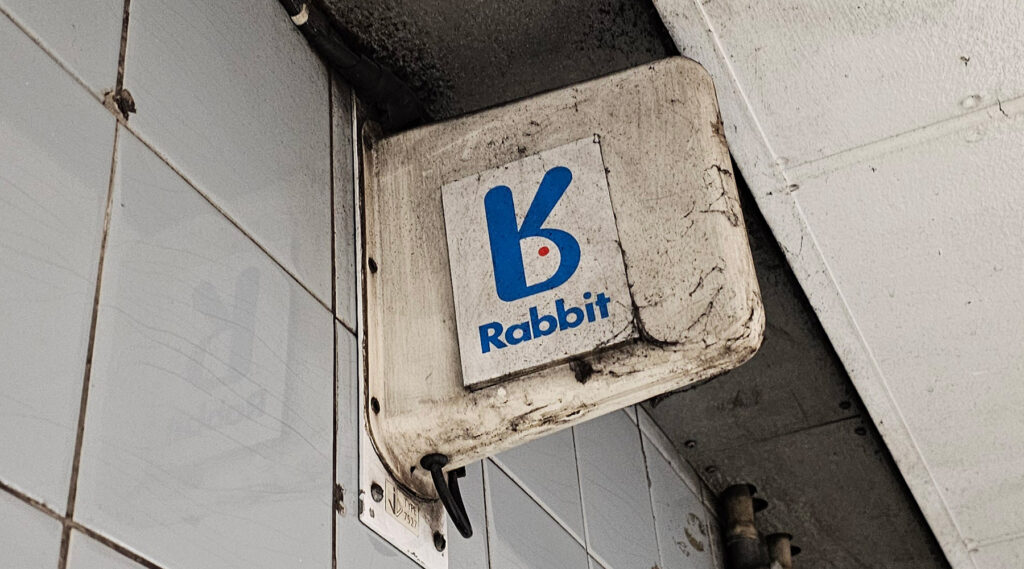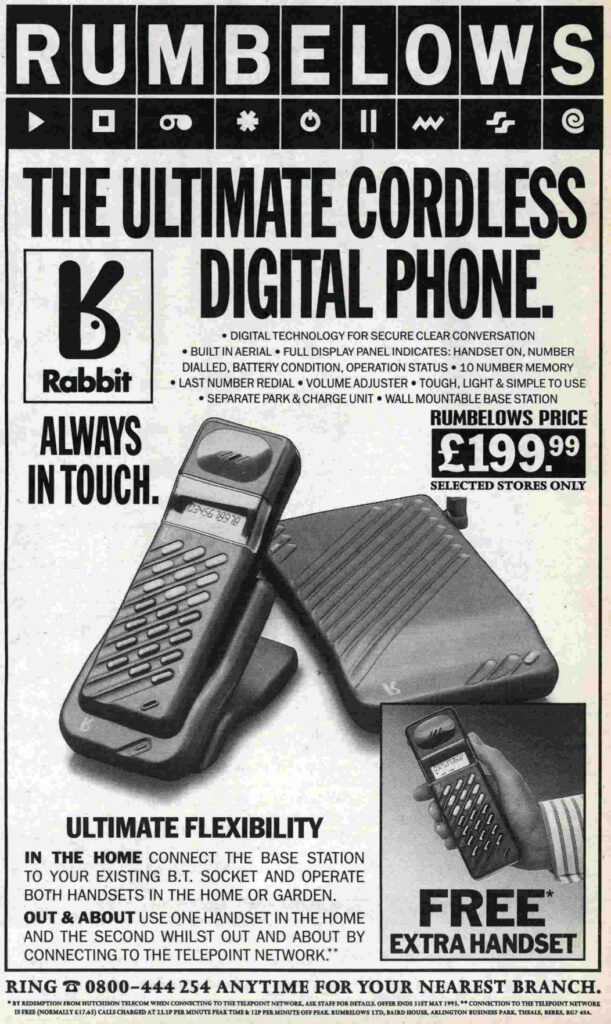For over thirty years, a dead rabbit has hung inside Seven Sisters tube station, and thousands of people walk past it every day without noticing.
The dead rabbit is a legacy of an early form of mobile phone technology, albeit one that lasted less than two years before closing down.
We need to jump back to 1989, when the government awarded four licenses to operate Telepoint services, with the aim that their lower costs would offer competition to the country’s two mobile networks – Cellnet (now O2) and Vodafone.
At a time when the two mobile networks had 500,000 customers between them, it was expected these Telepoint phones would have as many as seven million customers by the middle of the 1990s.
Rabbit was created by the Hong-Kong based conglomerate, Hutchison, which didn’t have a license to operate a telepoint service, so they bought one of the four companies that did. However, by the time the company was ready to launch Rabbit to the world, the other three companies — Mercury Callpoint, Ferranti’s Zonephone and BT’s Phonepoint — had already closed down.
Rabbit pushed on and, with a huge marketing blitz, finally started appearing in the shops in May 1992.
Despite the fact that it could only make calls within 100 yards of a base station and couldn’t receive calls (you could get a pager telling you to call someone) — in theory, it should have been a success.
At the time, the two mobile networks were for business people and Yuppies, and were very expensive to use, so even the restrictive Rabbit phones would have an edge as they were much cheaper to make calls on – typically 50p a minute on a basic cellphone tariff vs 20p a minute on Rabbit. And cheaper monthly rentals.
The other factor is that the Rabbit phones could also be used at home.
Many homes had a cordless phone, but these domestic analogue radio-based cordless phones were large and frankly pretty poor quality, with calls often dropping out. The Rabbit phones came with a home base station and used early digital phone technologies, so the sound quality was considerably better. And the handset was much smaller than the home cordless phone.
So, when Rabbit hopped into the shops in May 1992, sales were expected to be brisk, and indeed, they were. Initially.
I worked in a shop selling them, and from memory the mobile calling function was only about half the appeal — it was the substantially better home phone function that really appealed to people when they heard about it from friends.
Rabbit launched with base stations on shop fronts and lamposts across Manchester and quickly spread, reaching nationwide coverage by late 1993.
Then it abruptly closed down.
On a day to remember, Friday 5th November, Hutchison Telecom suddenly announced that it was shutting down the Rabbit service. Hutchison Telecom had recently been granted a license to build a full mobile network and wasn’t interested in its old Telepoint based service anymore.
Customers who owned a Rabbit phone were given a refund, and a promise of a discount on Hutchison’s replacement, a GSM based mobile phone network — Orange (now EE).
The bunny had flopped. The future was Orange.
The announcement that Rabbit was closing down sparked something totally unexpected — a surge in sales.
Remember how I mentioned that the phones worked at home as a replacement for the clunky cordless phone — well, that wasn’t dependent on the Rabbit base stations, so the handsets would keep on working in the home after the mobile network was shut down.
And people really liked the Rabbit phone for their homes.
Awkwardly, customers offered a refund had to return the handsets, and many chose not to, while shops were told to return unsold stock to the warehouses, and many chose not to.
Hutchison’s attempt to kill the rabbit dead was struggling for life.
In the end, shops ran out of rabbit stock, and in December 1993, the Rabbit base stations switched off forever.
However, like many items of street furniture, what is installed in haste can take ages to remove at leisure. Unless the location is needed for something else, old signs and clutter can linger on for years, decades even.
So, inside Seven Sisters tube station, there’s still a Rabbit base station sitting on the wall, more than 30 years after it last broadcast a radio signal.
If you want to find the dead rabbit, just hop down to Seven Sisters tube station’s High Road entrance ticket hall. You can find it right next to the escalators to the Victoria line.
There’s also another one, in rather better condition, in the waiting room on platform 7/8 at Watford Junction station.









I’ve often wondered what they were, but not enough to Google them.
I’ve been seeing these signs for years. I’m sure there’s loads of them still around.
The waiting room at watford doesn’t look like it’s 32 years old. certainly been redecorated since then.
…How can the light that burned so brightly
Suddenly burn so pale?…Bright eyes…
Could do with a wipedown with a damp rag!
Any reason why it can’t just be removed?
From the photo it looks like there may be some electronics inside the sign. In which case it would require someone to either completely remove the wiring, or make it safe at the wall with a blank plate box or similar.
Probably not worth the hassle or money to do the work, unless part of a wider refurbishment of that area of the station. I suspect that stations have a lot of no longer used wiring that’s been left in place as it would cost more to remove, assuming they knew what it was for in the first place.
Wasn’t Hutchinson’s mobile company actually One2One, not Orange? They did merge and form EE later (and being T-Mobile for a short while)
No.
Yes, I’m completely wrong! Should have looked it up first 😂
I thought Hutchinson owned 3.
They do. Floated Orange in the 90s, sold their remaining stake off in the 00s then got the band together again for the 3G license round, creating Three.
more rabbit than Sainsbury’s |(rabbitrabbitrabbitrabbit)
I’m so glad you posted this!! I was telling a friend in her late 30s about the Rabbit network. After the initial mirth at the name now associated with another product thought I was kidding. I remember them being introduced Manchester where I was a student plus on stations – but always used pay phones myself!
There used to be one opposite the old ticket office at North Acton station. High up on the pillar. I haven’t worked at the station for a few years but it’s probably still there.
As others note, there were a fair few of these and other telepoint signs around until, well, a few years ago. I remember it all at the time. It was a good example of how the technology – here, proper GSM cellular – that wins does so because it comes out of nowhere, fast, and overtakes what seems like a better bet. As for “The future [i]s Orange”, the v/o artist for that firm’s ads for over 10 years – almost all its life – was Paul Vaughan, one of the top 4 in the trade at the time (the others being Sean Barrett, Andrew Sachs and John Hedges).
Paul Vaughan the voice you never forget from BBC Horizon and other documentaries.
I remember it well. A Rabbit phone and a pager was the EDC of the day. Someone who wanted to talk to you would page you, you then found a base station and called them back!
They did offer good deals on Orange phones when they stopped the service. I got a Nokia Orange phone, it would be a collectors item now!!
I remember seeing Bi-Bop all over Paris at around that time https://fr.wikipedia.org/wiki/Bi-Bop